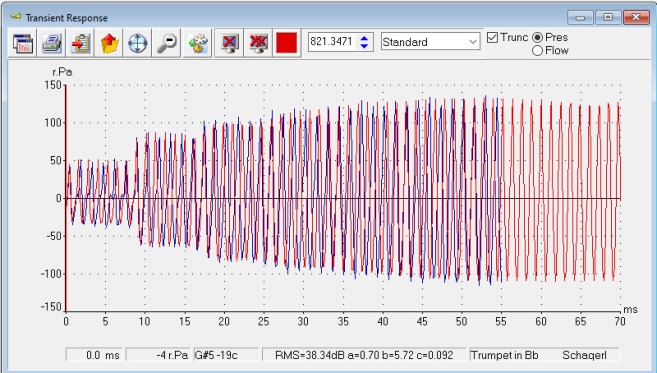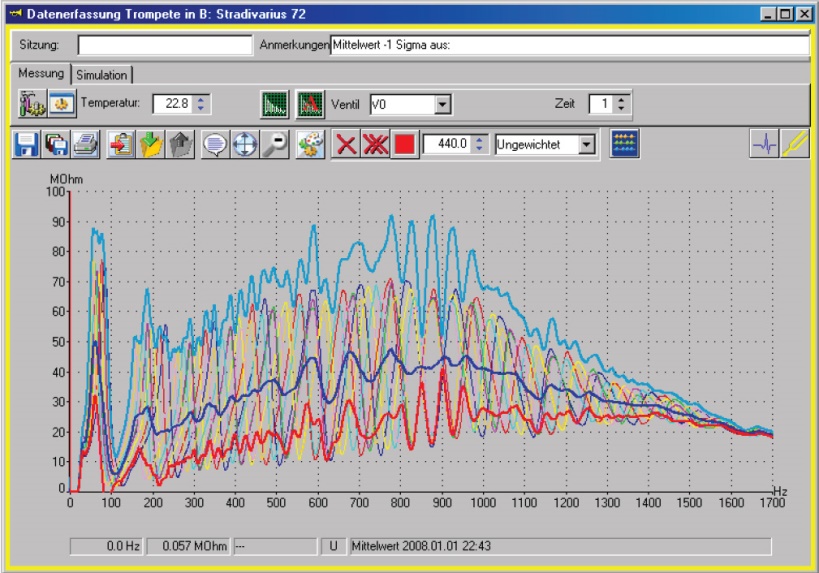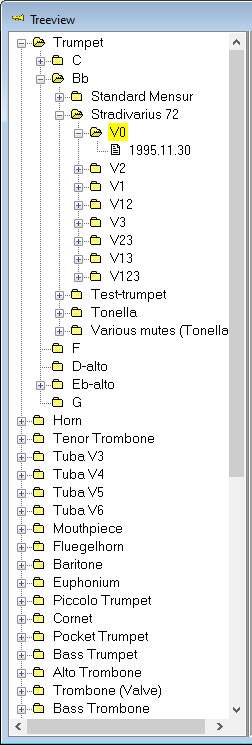An “impulse response” is obtained by sending an infinitely short impulse into the instrument. This effect is achieved in BIAS by a mathematical transformation of the impedance data from the frequency domain to the time domain.
The impulse response window can be used for a disturbance analysis, to accurately determine the “acoustic length” of the entire instrument or individual parts, and for response assessment. This is because when an impulse is sent through a tube (instrument), this impulse is reflected at points where the environment suddenly changes. Such “spots” are e.g. the end of the bell, obstacles such as incorrectly inserted valves, inaccurately machined ” joints” and remnants of soldered joints or leaking water keys, etc.
Example of the acoustic length of a Bb trumpet (no valve pressed).
At the bottom left (red circle) the length from the mouthpiece rim to the end of the bell is displayed in centimeters.
Example for the measurement of the slide length: drag the curve for the “empty” instrument into the impulse response window and the curve with the valve position whose acoustically effective slide length you want to measure.
Example of a disturbance at a distance of 215.1 cm from the mouthpiece rim of a horn in Fa. In the status line below, the “Pulse Reflection Factor” PRF (see figure below) is displayed in addition to other data of the instrument. The higher the % value, the better the response characteristics. However, if the value is too high, the instrument is perceived as “stiff and inflexible”.

This window shows for any tone (frequency) the time until the standing wave has settled (=tone onset). The individual sound wave oscillations and their amplitude can be seen. This allows conclusions to be drawn about the response and the pull-in range. In the left figure (Tuba in Fa), after the first 24 milliseconds, you can clearly see the establishment of the standing wave by the arrival of the first reflection of the sound wave from the bell end at the mouthpiece.
You can drag any number of tones from any number of different instruments into the transient window, as the illustration on the right indicates (Two different trumpets). Clicking on the export icon in the menu bar generates a wav file from this, which you can play back with any player. This allows you to listen to the first 1.3 seconds of any number of instruments one after the other and compare them regarding tone onset and timbre. In addition, you can analyze the limits and differences of the pull-in range of the tones and the behavior of an instrument in the various dynamic levels.
Calculate the mean value of any number of instruments with just one mouse click.
or create “tolerance bands” of any width.
Show with only one mouse click the average deviation of the intonation of all instruments of a certain manufacturer or the average acoustic length of its instruments or certain slides.
Cyan: upper tolerance limit
Blue: average value
Red: lower tolerance limit
The database is structured like the Windows Explorer. For each instrument type there is a folder, for example “Trumpet” or “Horn”.
In such folders you find subfolders for trumpet in C, in Bb, etc. In the directory “trumpet in C” there are again subdirectories for the individual valve configurations to be measured (V0= the open instrument, V1= 1st valve pressed, V13= 1st and 3rd valve pressed, etc.). The actual measurements are then located in these directories.
One measurement per valve combination is sufficient, but you can store any number of measurements in them (e.g. with different mouthpieces or leadpipes). If you measure a new instrument, BIAS automatically creates such an empty directory with one mouse click and with another mouse click the data is automatically filled in correctly after the completed measurements.
The BIAS Basic Edition is also available for woodwind instruments only with a corresponding database or as a combination for brass and woodwind instruments.
All BIAS editions include the Musical Calculator, an extremely handy tool that takes the hassle out of transposing and is versatile in its use.

For details please click here.











